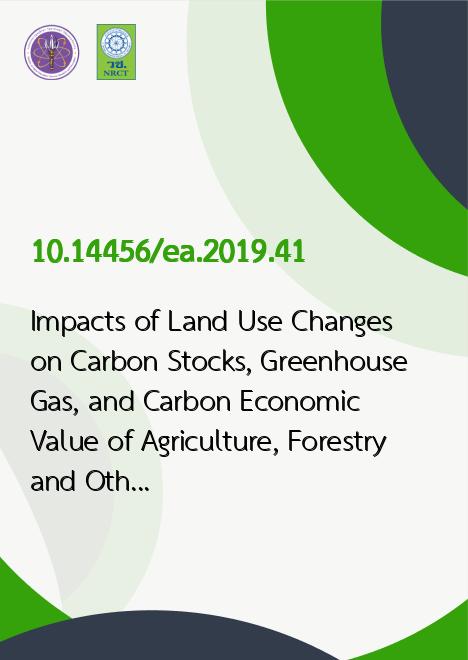
|
Impacts of Land Use Changes on Carbon Stocks, Greenhouse Gas, and Carbon Economic Value of Agriculture, Forestry and Other Land Use (AFOLU) Sector in Coastal Area of Yi San Sub-District, Samut Songkhram Province, Thailand between 2001 and 2015 |
|---|---|
| รหัสดีโอไอ | |
| Creator | 1. Sopana Jantawong 2. Nipon Tangtham 3. Puntip Jongkroy |
| Title | Impacts of Land Use Changes on Carbon Stocks, Greenhouse Gas, and Carbon Economic Value of Agriculture, Forestry and Other Land Use (AFOLU) Sector in Coastal Area of Yi San Sub-District, Samut Songkhram Province, Thailand between 2001 and 2015 |
| Publisher | Thai Society of Higher Education Institutes on Environment |
| Publication Year | 2562 |
| Journal Title | EnvironmentAsia |
| Journal Vol. | 12 |
| Journal No. | 3 |
| Page no. | 12-22 |
| Keyword | Land Use Changes, Carbon Stocks, Carbon Economic Value, AFOLU Sector, Coastal Area, Samut Songkhram Province, Thailand |
| URL Website | http://www.tshe.org/ea/index.html |
| Website title | EnvironmentAsia |
| ISSN | 1906-1714 |
| Abstract | The objectives of this research were to 1) study changes in land use of Agriculture, Forestry and Other Land Use (AFOLU) sector using GIS application as a tool for accounting land use type area for each given periods, 2) to estimate the amount of carbon stocks, and carbon dioxide emissions and removals from changes of 6 land use types (mangrove forest, cropland, grassland, wetlands, settlements, and aquaculture land) which were evaluated under the standard method of the 2006 IPCC Guideline for National Greenhouse Gas Inventories, and 3) to evaluate the economic value of carbon dioxide based on existing carbon price in California Carbon Market. The result showed that between 2001 and 2015 in Yi San Sub-district, Samut Songkhram Province, different types of land use were changed from aquaculture to mangrove forest (974.37 ha), followed by mangrove forest to aquaculture (770.75 ha), respectively. Mangrove forests increased in carbon stocks due to biomass growth of 50,730.63 tC and the large proportions of decrease in carbon stocks in biomass were from aquaculture land as -21,735.14 tC. The estimation of total carbon dioxide emissions was +123,043.83 tCO2 and total carbon dioxide removals were -190,409.73 tCO2. The land use with the highest carbon dioxide emission was the aquaculture land (+81,696.64 tCO2), followed by the grassland (+35,058.26 tCO2) and settlements (+5,509.30 tCO2), respectively. The land use with the highest amount of carbon dioxide removal was the mangrove forest (-186,012.28 tCO2), followed by the cropland (-2,257.41 tCO2) and grassland (-2,140.04 tCO2), respectively. The highest gain of economic value from CO2 removals was the mangrove forest (2,808,785.43 USD) followed by cropland (22,314.48 USD). The highest economic loss from CO2 emissions was the aquaculture land (1,233,619.26 USD) followed by the grassland (497,065.12 USD) and settlements (83,190.43 USD), respectively. As a result, those land use changes can reduce global warming potential (GWP) up to -67,365.90 tCO2e and increase the net total carbon economic value as 1,017,225.09 USD. |